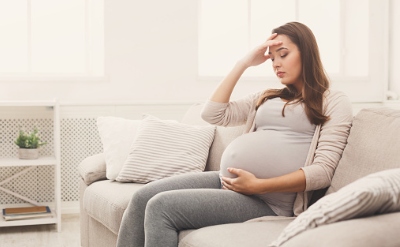Women who experience migraines during pregnancy are more likely to have a stroke during pregnancy, delivery, or the postpartum period, a new study suggests.
Researchers examined data from a retrospective California birth cohort of 3 million singleton live births from 2007 to 2012 that was created from birth certificates and hospital discharge records. There were 26,440 women with a diagnosis of migraines during pregnancy, a rate of 914 per 100,000 deliveries.
A total of 843 women had a stroke, a rate of 29 per 100,000 deliveries; 58% of these cases were ischemic stroke.

After adjusting for age, BMI, race/ethnicity, nativity, payer source, mental illness, smoking, drug or alcohol use, and diabetes, women with migraines were 60% more likely to have a hypertensive disorder during pregnancy (adjusted relative risk 1.6). They were also more than six times as likely to have a stroke during pregnancy or delivery (aRR 6.8) and more than twice as likely to have a stroke postpartum (aRR 2.1).
"One way migraine might increase the risk is through endothelial dysfunction which is also related to pregnancy-induced hypertension," said Bizu Gelaye, an assistant professor of epidemiology at the Harvard T. H. Chan School of Public Health, in Boston, who wasn't involved in the study.
"In addition, pro-inflammatory responses associated with migraine might lead to endothelial dysfunction therefore leading to further risk of stroke," Gelaye said by email. "Other biological pathways might include neural pain pathways, cortical excitability and genetic risk factors."
Compared to women who didn't have migraines during pregnancy, those who did were more likely to be white, have private health insurance, obesity, diabetes, or a mental health disorder, and more likely to use tobacco, drugs and alcohol, the researchers report in JAMA Neurology.
More than twice the proportion of women with migraines during pregnancy (15.1%) had hypertensive disorders, compared to women without migraines (7%).
And 0.15% of women with migraines had a stroke during pregnancy or delivery, compared with 0.01% of women without migraines. Postpartum, 0.05% of women with migraines during pregnancy had a stroke compared with 0.01% of women without migraines.
"We know that the prevalence of migraine is highest during the reproductive years, with up to 25% of women of reproductive age affected by the disease," said Dr. Kasper Adelborg, an associate professor at Aarhus University Hospital in Denmark who wasn't involved in the study.
"In this study, only 1% of pregnant women had migraine and although there was an association between migraine and stroke on the relative scale, the absolute stroke risk was still low," Dr. Adelborg said by email. "This fact is reassuring I think."
The effects were twice as strong for ischemic stroke as for hemorrhagic stroke, the study team writes, although they didn't report these results.
Lead author Gretchen Bandoli of the University of California, San Diego didn't respond to emails seeking comment.
One limitation of the study is that the timing of migraine, hypertension, and stroke wasn't clear, making it impossible to know whether these diagnoses preceded a stroke, the study team notes.
It's also possible that only severe migraines were recorded in hospital discharge records used for the analysis, and that some migraines during pregnancy may have been misdiagnosed, the authors point out.
Even so, clinicians should consider migraines when addressing the risk of possible complications during pregnancy or during the postpartum period, said Dr. Simona Sacco, a professor of neurology at the University of L'Aquila, in Italy, who wasn't involved in the study.
"It is important to note that many women are not aware to suffer from migraine and consider normal to have sometimes troublesome headache," Dr. Sacco said by email. "In many cases there is also misdiagnosis as women may (attribute) their headache to other conditions such as sinusitis or disorders of the cervical spine rather than recognizing them as a form of migraine."
Recognition of migraine history and proper diagnosis is important for minimizing the risk of stroke, Dr. Sacco added. "There is a need of increased awareness of this disorder both in physicians and in the general public."
SOURCE: https://bit.ly/2U76qQZ JAMA Neurology, online June 1, 2020.
